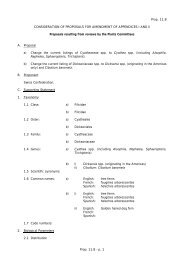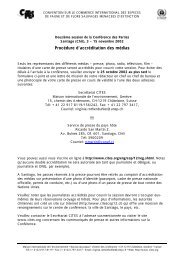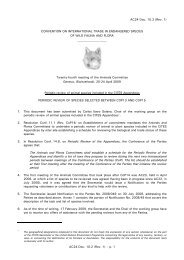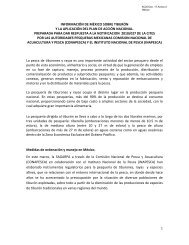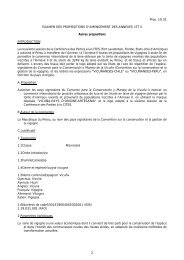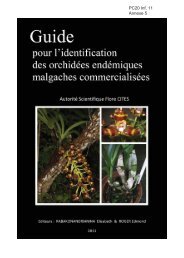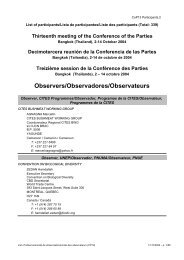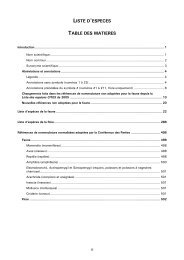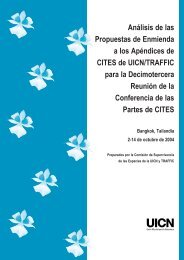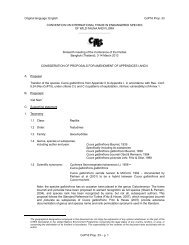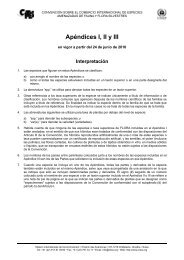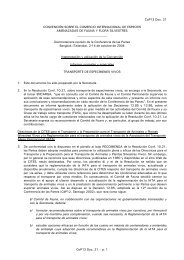Lamna nasus - Cites
Lamna nasus - Cites
Lamna nasus - Cites
You also want an ePaper? Increase the reach of your titles
YUMPU automatically turns print PDFs into web optimized ePapers that Google loves.
Draft Proposal to list <strong>Lamna</strong> <strong>nasus</strong> in Appendix II - prepared by Germany in January 2012<br />
Table 1. Key to index of percentage decline illustrated in Figure 2.<br />
Index Trend (to % of<br />
baseline<br />
Northeast Atlantic<br />
1 All landings 13%<br />
2 Norwegian landings 1%<br />
3 Danish landings 1%<br />
4 Recent French catch per unit<br />
effort (CPUE)<br />
5 Biomass (surplus production<br />
model)<br />
6 Biomass (age structured<br />
production model)<br />
7 Stock abundance (age<br />
structured production model)<br />
Mediterranean<br />
66%<br />
15-39%<br />
6%<br />
7%<br />
8 All observations 1%<br />
9 Ligurian Sea catches 1%<br />
10 Ionian Sea CPUE 2%<br />
Page 5 of 14<br />
AC26 Doc. 26.2<br />
Annex / Anexo /Annexe<br />
(English only / únicamente en inglés / seulement en anglais)<br />
Index<br />
Northwest Atlantic<br />
Trend (to % of<br />
baseline<br />
11 All landings 4%<br />
12 Stock biomass (surplus production<br />
model)<br />
32%<br />
13 Stock abundance (age structured<br />
production model)<br />
22-27%<br />
14 Mature female abundance (age<br />
structured production model)<br />
12-16%<br />
Southwest Atlantic<br />
15 Stock biomass (surplus production<br />
model)<br />
18-39%<br />
16 Spawning Stock Biomass (age<br />
structured production model)<br />
18%<br />
Southern Oceans<br />
17 Recent NZ landings 25%<br />
18 Recent NZ longline CPUE 30%<br />
19 Recent Japanese bluefin tuna bycatch<br />
CPUE<br />
no trend<br />
The IUCN Red List status assessment for porbeagle is Vulnerable globally, Critically Endangered in the<br />
Northeast Atlantic and the Mediterranean (past, ongoing and estimated future reductions in population size<br />
exceeding 90%), Endangered in the Northwest Atlantic (estimated reductions exceeding 70% that have now<br />
ceased through management, and Near Threatened in the Southern Ocean (Stevens et al. 2005). Table 1<br />
summarises available information on stock trends from historic baseline and some more recent trend data.<br />
The North Atlantic has historically been the major reported source of world catches, with detailed long-term<br />
fisheries trend data available. Landings here have exhibited marked declining trends over the past 60–70 years<br />
(see below) during a period of rising fishing effort and market demand for this valuable species and improved<br />
fisheries technology. Reported North Atlantic catches (FAO FISHSTAT) during the past decade were less<br />
than 10% of those during the past 50 years (only partly due to the recent introduction of restrictive catch<br />
quotas). Fewer Southern hemisphere data are available (reporting to FAO only commenced in the 1990s), but<br />
some of these also show declining trends. FAO porbeagle catch data (Figure 4) are generally lower than that<br />
from other sources (national landings, ICES data etc.). Under-reporting is widespread, ‘grossly’ so in the<br />
South Atlantic (ICES/ICCAT 2009). Landings from the NAFO Regulatory Area reported to NAFO “seldom<br />
resembled those reported to ICCAT... 2005–2006 catches by countries other than Canada are in doubt and<br />
probably under reported” (Campana and Gibson 2008).<br />
Stock assessments available for the Atlantic (ICCAT/ICES 2009) illustrate the correlation between steep<br />
declines in landings and catch per unit effort (CPUE) and declining biomass. CPUE and landings are therefore<br />
used as indicators of population trends for this valuable commercial species in unmanaged fisheries<br />
elsewhere, while recognizing that other factors may also affect catchability.<br />
4.4.1 North Atlantic and Mediterranean<br />
Most of the fisheries targeting seriously depleted shelf stocks in the Northeast and Northwest Atlantic are now<br />
under stringent management, but not in the Mediterranean. High seas Tuna and Swordfish longline fisheries<br />
also exploit these stocks (as target or retained bycatch) in the NAFO, ICCAT and GFCM regulatory areas,<br />
where porbeagle shark catches remain largely unregulated, except for shark finning bans.<br />
Northeast Atlantic<br />
The Northeast Atlantic age structured production model stock assessment estimated a decline from baseline of<br />
over 90%, to far below the maximum sustainable yield (MSY), at 6% of biomass and 7% of numbers. An<br />
alternative surplus production model estimated that biomass had declined to between 15% and 39% of<br />
AC26 Doc. 26.2, Annex 1 – p. 5




